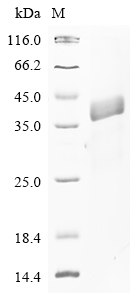Recombinant Human Sulfhydryl oxidase 1 (QSOX1) , partial
CAT:
399-CSB-EP019144HU1-01
Size:
20 µg
Price:
Ask
- Availability: 24/48H Stock Items & 2 to 6 Weeks non Stock Items.
- Dry Ice Shipment: No




Recombinant Human Sulfhydryl oxidase 1 (QSOX1) , partial
- CAS Number: 9000-83-3
- Gene Name: QSOX1
- UniProt: O00391
- Expression Region: 101-175aa
- Organism: Homo sapiens
- Target Sequence: CAEETNSAVCRDFNIPGFPTVRFFKAFTKNGSGAVFPVAGADVQTLRERLIDALESHHDTWPPACPPLEPAKLEE
- Tag: N-terminal 10xHis-GST-tagged and C-terminal Myc-tagged
- Source: E.coli
- Field of Research: Cell Biology
- Assay Type: Developed Protein
- Relevance: Catalyzes the oxidation of sulfhydryl groups in peptide and protein thiols to disulfides with the reduction of oxygen to hydrogen peroxide. Plays a role in disulfide bond formation in a variety of extracellular proteins. In fibroblasts, required for normal incorporation of laminin into the extracellular matrix, and thereby for normal cell-cell adhesion and cell migration.
- Purity: Greater than 85% as determined by SDS-PAGE.
- Activity: Not Test
- Length: Partial
- Form: Liquid or Lyophilized powder
- Buffer: If the delivery form is liquid, the default storage buffer is Tris/PBS-based buffer, 5%-50% glycerol. If the delivery form is lyophilized powder, the buffer before lyophilization is Tris/PBS-based buffer, 6% Trehalose, pH 8.0.
- Reconstitution: We recommend that this vial be briefly centrifuged prior to opening to bring the contents to the bottom. Please reconstitute protein in deionized sterile water to a concentration of 0.1-1.0 mg/mL.We recommend to add 5-50% of glycerol (final concentration) and aliquot for long-term storage at -20℃/-80℃. Our default final concentration of glycerol is 50%. Customers could use it as reference.
- Molecular Weight: 43.4 kDa
- References & Citations: "Intracellular catalysis of disulfide bond formation by the human sulfhydryl oxidase, QSOX1." Chakravarthi S., Jessop C.E., Willer M., Stirling C.J., Bulleid N.J. Biochem. J. 404:403-411 (2007)
- Storage Conditions: The shelf life is related to many factors, storage state, buffer ingredients, storage temperature and the stability of the protein itself. Generally, the shelf life of liquid form is 6 months at -20℃/-80℃. The shelf life of lyophilized form is 12 months at -20℃/-80℃.
